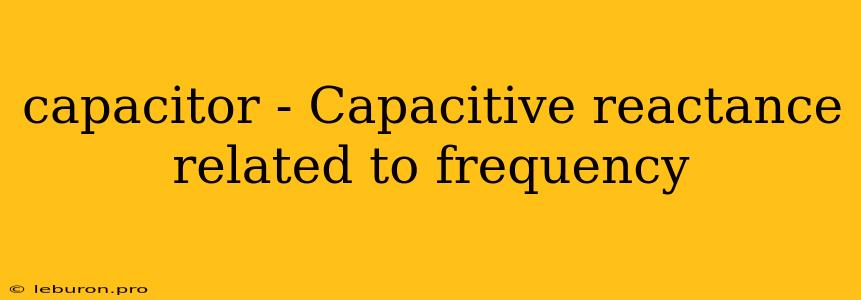Capacitors are passive electronic components that store electrical energy in an electric field. They are essential components in many electronic circuits, playing crucial roles in filtering, smoothing, and timing applications. One of the key characteristics of a capacitor is its capacitive reactance, which describes its opposition to the flow of alternating current (AC). Capacitive reactance is inversely proportional to the frequency of the AC signal, meaning that the higher the frequency, the lower the capacitive reactance. This relationship between capacitive reactance and frequency has significant implications for how capacitors behave in AC circuits.
Understanding Capacitive Reactance
Capacitive reactance, denoted by Xc, is measured in ohms (Ω) and represents the opposition a capacitor offers to the flow of alternating current. It is influenced by the capacitor's capacitance (C) and the frequency (f) of the AC signal. The formula for capacitive reactance is:
Xc = 1 / (2πfC)
This formula reveals the inverse relationship between capacitive reactance and frequency. As the frequency increases, the denominator in the equation becomes larger, resulting in a smaller value for Xc. Conversely, as the frequency decreases, the denominator becomes smaller, leading to a larger Xc.
How Capacitive Reactance Changes with Frequency
To understand the impact of frequency on capacitive reactance, let's consider a simple example. Imagine a capacitor connected to an AC voltage source. When the frequency of the AC signal is low, the capacitor has ample time to charge and discharge during each cycle. This means that a significant amount of current can flow through the capacitor, resulting in a lower capacitive reactance.
However, as the frequency increases, the time available for the capacitor to charge and discharge during each cycle decreases. Consequently, less current can flow through the capacitor, leading to a higher capacitive reactance.
Practical Applications of Capacitive Reactance
The relationship between capacitive reactance and frequency has numerous practical applications in electronic circuits:
1. Frequency-Dependent Filtering:
Capacitive reactance is crucial for designing frequency-dependent filters. Capacitors can be used to filter out specific frequencies from a signal. For example, a capacitor connected in series with a load can act as a high-pass filter, allowing high-frequency signals to pass through while blocking low-frequency signals. The reason for this filtering action is that the capacitive reactance is low for high frequencies, allowing them to pass through the capacitor, while it is high for low frequencies, effectively blocking their passage.
2. Capacitive Coupling:
Capacitors can be used to couple AC signals between stages of an amplifier or other circuits. By connecting a capacitor between the output of one stage and the input of the next, AC signals can pass through while DC signals are blocked. This is because capacitive reactance is low for the AC signal frequency, allowing it to pass through, but high for the DC signal frequency, effectively blocking it.
3. Capacitor-Based Oscillators:
Capacitors are essential components in many electronic oscillators, which generate periodic signals. The capacitive reactance of the capacitor in an oscillator circuit determines the frequency of the generated signal. By varying the capacitor value or the frequency of the oscillator, the output frequency can be adjusted.
4. Capacitor-Based Timing Circuits:
Capacitors are used in timing circuits, where the rate of charge and discharge of the capacitor determines the duration of a time interval. The capacitive reactance of the capacitor influences the charging and discharging time, allowing precise timing control in various applications, such as digital clocks and timers.
Conclusion
Capacitive reactance is a fundamental concept in understanding the behavior of capacitors in AC circuits. Its inverse relationship with frequency has significant implications for filter design, signal coupling, oscillator operation, and timing circuits. By understanding capacitive reactance, engineers can effectively design and implement circuits that utilize capacitors to achieve desired filtering, coupling, and timing functionalities.
